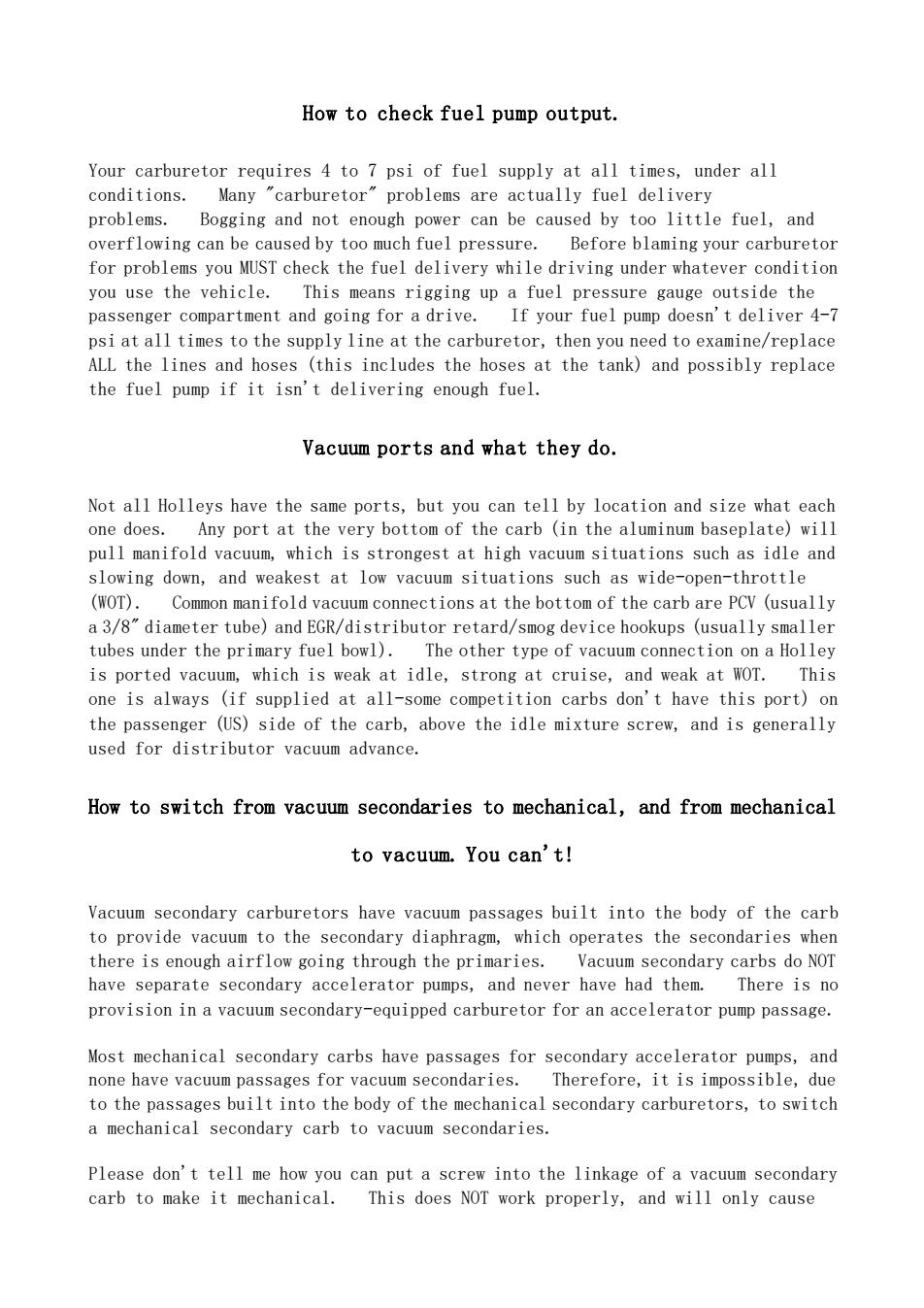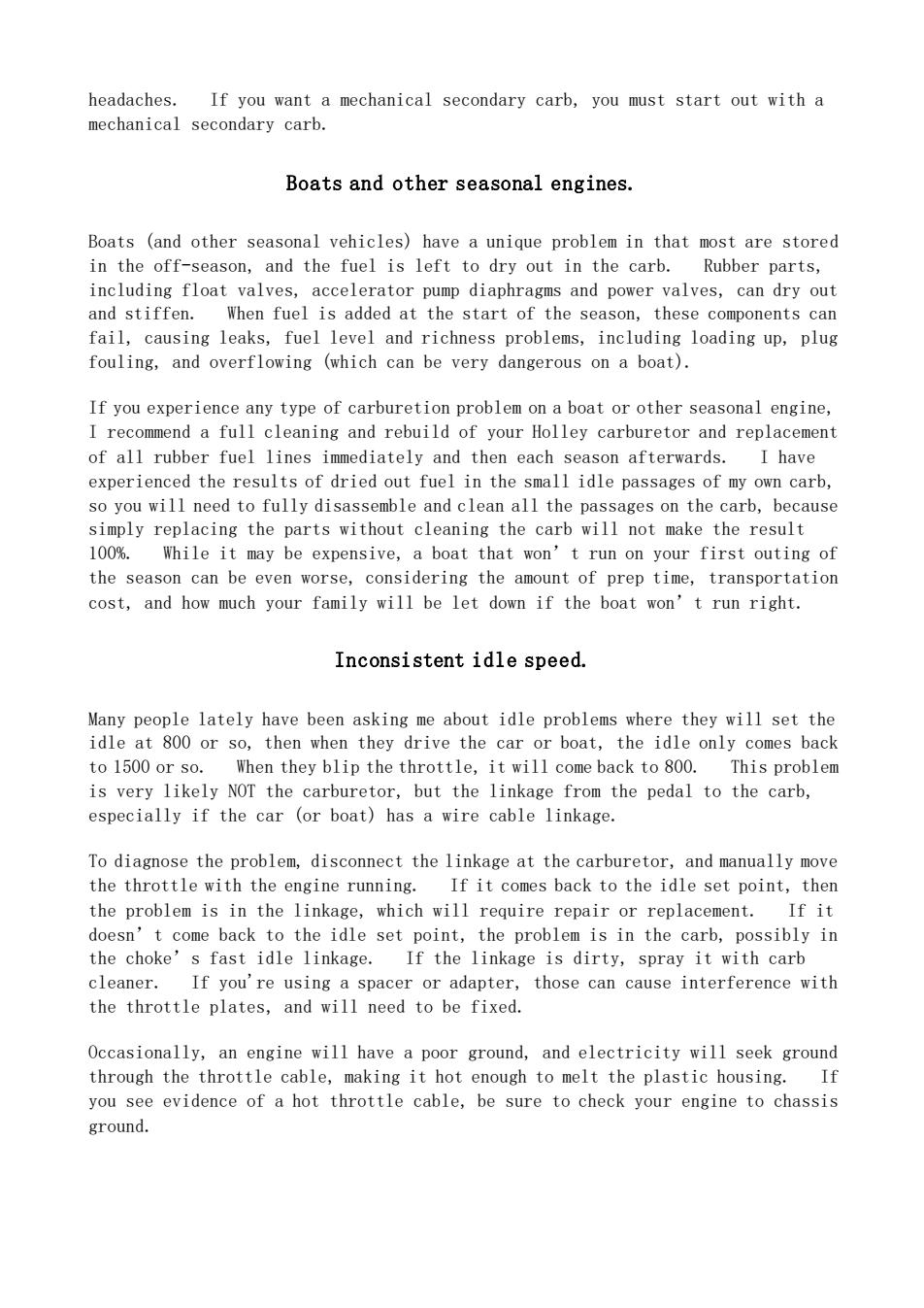
How to check fuel pump output.Your carburetor requires 4 to 7 psi of fuel supply at all times, under allMany"carburetor"problems are actually fuel deliveryconditions.problems.Bogging and not enough power can be caused by too little fuel, andoverflowingcanbecausedbytoomuchfuelpressure.Before blaming your carburetorforproblemsyouMusTcheck thefuel deliverywhiledrivingunderwhateverconditionyouuse the vehicle.This means rigging up a fuel pressure gauge outside thepassengercompartmentandgoingforadrive.Ifyourfuelpumpdoesn'tdeliver4-7psi at all times to the supply line at the carburetor, then you need to examine/replaceALL the lines and hoses (this includes the hoses at the tank) and possibly replacethe fuel pump if it isn't delivering enough fuel.Vacuum ports and what they do.Not all Holleys have the same ports, but you can tell by location and size what eachonedoes.Any port at the verybottom of the carb(inthe aluminumbaseplate)willpull manifold vacuum, which is strongest at high vacuum situations such as idle andslowing down, and weakest at low vacuum situations such as wide-open-throttle(wor).Common manifoldvacuum connections at thebottom of the carb are PCv (usuallya3/8"diametertube)andEGR/distributorretard/smogdevicehookups(usuallysmallertubesundertheprimaryfuelbowl).Theothertypeof vacuumconnection onaHolleyis ported vacuum, which is weak at idle, strong at cruise, and weak at woT.Thisone is always (if supplied at all-some competition carbs don't have this port) onthe passenger (Us) side of the carb, above the idle mixture screw, and is generallyused for distributor vacuum advance.How to switch from vacuum secondaries to mechanical, and from mechanicalto vacuum. You can't!Vacuum secondary carburetors have vacuum passages built into the body of the carbto provide vacuum to the secondary diaphragm, which operates the secondaries whenthereisenoughairflowgoing throughtheprimaries.Vacuum secondarycarbsdoNOThave separate secondary accelerator pumps, and never have had them.Thereis noprovision in a vacuum secondary-equipped carburetor for an accelerator pump passage.Most mechanical secondary carbs havepassages for secondaryaccelerator pumps, andnonehave vacuumpassagesfor vacuum secondaries.Therefore,itisimpossible,dueto the passages built into thebody of themechanical secondary carburetors,to switcha mechanical secondary carb to vacuum secondaries.Please don't tell me how you can put a screw into the linkage of a vacuum secondarycarb to make it mechanical.This does NOT work properly, and will only cause
How to check fuel pump output. Your carburetor requires 4 to 7 psi of fuel supply at all times, under all conditions. Many "carburetor" problems are actually fuel delivery problems. Bogging and not enough power can be caused by too little fuel, and overflowing can be caused by too much fuel pressure. Before blaming your carburetor for problems you MUST check the fuel delivery while driving under whatever condition you use the vehicle. This means rigging up a fuel pressure gauge outside the passenger compartment and going for a drive. If your fuel pump doesn't deliver 4-7 psi at all times to the supply line at the carburetor, then you need to examine/replace ALL the lines and hoses (this includes the hoses at the tank) and possibly replace the fuel pump if it isn't delivering enough fuel. Vacuum ports and what they do. Not all Holleys have the same ports, but you can tell by location and size what each one does. Any port at the very bottom of the carb (in the aluminum baseplate) will pull manifold vacuum, which is strongest at high vacuum situations such as idle and slowing down, and weakest at low vacuum situations such as wide-open-throttle (WOT). Common manifold vacuum connections at the bottom of the carb are PCV (usually a 3/8" diameter tube) and EGR/distributor retard/smog device hookups (usually smaller tubes under the primary fuel bowl). The other type of vacuum connection on a Holley is ported vacuum, which is weak at idle, strong at cruise, and weak at WOT. This one is always (if supplied at all-some competition carbs don't have this port) on the passenger (US) side of the carb, above the idle mixture screw, and is generally used for distributor vacuum advance. How to switch from vacuum secondaries to mechanical, and from mechanical to vacuum. You can't! Vacuum secondary carburetors have vacuum passages built into the body of the carb to provide vacuum to the secondary diaphragm, which operates the secondaries when there is enough airflow going through the primaries. Vacuum secondary carbs do NOT have separate secondary accelerator pumps, and never have had them. There is no provision in a vacuum secondary-equipped carburetor for an accelerator pump passage. Most mechanical secondary carbs have passages for secondary accelerator pumps, and none have vacuum passages for vacuum secondaries. Therefore, it is impossible, due to the passages built into the body of the mechanical secondary carburetors, to switch a mechanical secondary carb to vacuum secondaries. Please don't tell me how you can put a screw into the linkage of a vacuum secondary carb to make it mechanical. This does NOT work properly, and will only cause

headaches.If you want a mechanical secondary carb, you must start out with amechanical secondary carb.Boats and other seasonal engines.Boats (and other seasonal vehicles) have a unique problem in that most are storedin the off-season, and the fuel is left to dry out in the carb.Rubber parts,including float valves, accelerator pump diaphragms and power valves, can dry outWhen fuel is added at the start of the season, these components canandstiffen.fail, causing leaks, fuel level and richness problems, including loading up, plugfouling, and overflowing (which can be very dangerous on a boat).If you experience any type of carburetion problem on a boat or other seasonal engine,I recommend a full cleaning and rebuild of your Holley carburetor and replacementof all rubber fuel lines immediately and then each season afterwards.I haveexperienced the results of dried out fuel in the small idle passages of my own carb,so you will need to fully disassemble and clean all the passages on the carb, becausesimply replacing the parts without cleaning the carb will not make the result100%.While it may be expensive,aboatthatwont run on your first outing oftheseasoncan.beevenworse,considerinamount ofpreptime,transportationthecost,andhowmuchyourfamilywillbelet down if the boat won' t run right.Inconsistent idle speed.Many people lately have been asking me about idle problems where they will set theidleat 8ooor so,thenwhentheydrivethecar orboat,the idleonlycomesbackto1500orso.Whentheyblipthethrottle,itwillcomebackto8oo.Thisproblemis very likely NoT the carburetor,but the linkage from the pedal to the carb,especiallyif thecar(or boat)has awire cablelinkage.To diagnose the problem, disconnect the linkage at the carburetor, and manually movethe throttle with the engine running.Ifitcomesbacktotheidlesetpoint,thenthe problem is in the linkage, which will require repair or replacement.If itdoesntcomebacktotheidlesetpoint,theproblemisinthecarb,possiblyinthe choke' s fast idle linkage.If the linkage is dirty,spray it with carbcleaner.If you're using a spacer or adapter, those can cause interference withthe throttle plates, and will need to be fixed.Occasionally, an engine will have a poor ground, and electricity will seek groundIfthrough the throttle cable,making it hot enough tomelt the plastic housing.you see evidence of a hot throttle cable, be sure to check your engine to chassisground
headaches. If you want a mechanical secondary carb, you must start out with a mechanical secondary carb. Boats and other seasonal engines. Boats (and other seasonal vehicles) have a unique problem in that most are stored in the off-season, and the fuel is left to dry out in the carb. Rubber parts, including float valves, accelerator pump diaphragms and power valves, can dry out and stiffen. When fuel is added at the start of the season, these components can fail, causing leaks, fuel level and richness problems, including loading up, plug fouling, and overflowing (which can be very dangerous on a boat). If you experience any type of carburetion problem on a boat or other seasonal engine, I recommend a full cleaning and rebuild of your Holley carburetor and replacement of all rubber fuel lines immediately and then each season afterwards. I have experienced the results of dried out fuel in the small idle passages of my own carb, so you will need to fully disassemble and clean all the passages on the carb, because simply replacing the parts without cleaning the carb will not make the result 100%. While it may be expensive, a boat that won’t run on your first outing of the season can be even worse, considering the amount of prep time, transportation cost, and how much your family will be let down if the boat won’t run right. Inconsistent idle speed. Many people lately have been asking me about idle problems where they will set the idle at 800 or so, then when they drive the car or boat, the idle only comes back to 1500 or so. When they blip the throttle, it will come back to 800. This problem is very likely NOT the carburetor, but the linkage from the pedal to the carb, especially if the car (or boat) has a wire cable linkage. To diagnose the problem, disconnect the linkage at the carburetor, and manually move the throttle with the engine running. If it comes back to the idle set point, then the problem is in the linkage, which will require repair or replacement. If it doesn’t come back to the idle set point, the problem is in the carb, possibly in the choke’s fast idle linkage. If the linkage is dirty, spray it with carb cleaner. If you're using a spacer or adapter, those can cause interference with the throttle plates, and will need to be fixed. Occasionally, an engine will have a poor ground, and electricity will seek ground through the throttle cable, making it hot enough to melt the plastic housing. If you see evidence of a hot throttle cable, be sure to check your engine to chassis ground